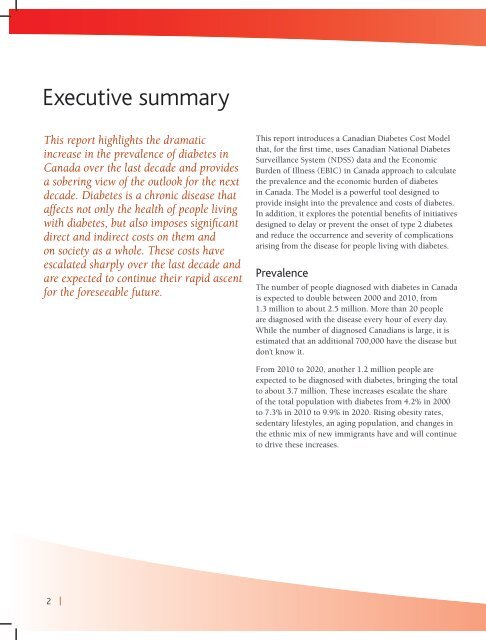An economic tsunami - Canadian Diabetes Association
An economic tsunami - Canadian Diabetes Association
An economic tsunami - Canadian Diabetes Association
You also want an ePaper? Increase the reach of your titles
YUMPU automatically turns print PDFs into web optimized ePapers that Google loves.
Executive summary<br />
This report highlights the dramatic<br />
increase in the prevalence of diabetes in<br />
Canada over the last decade and provides<br />
a sobering view of the outlook for the next<br />
decade. <strong>Diabetes</strong> is a chronic disease that<br />
affects not only the health of people living<br />
with diabetes, but also imposes significant<br />
direct and indirect costs on them and<br />
on society as a whole. These costs have<br />
escalated sharply over the last decade and<br />
are expected to continue their rapid ascent<br />
for the foreseeable future.<br />
This report introduces a <strong>Canadian</strong> <strong>Diabetes</strong> Cost Model<br />
that, for the first time, uses <strong>Canadian</strong> National <strong>Diabetes</strong><br />
Surveillance System (NDSS) data and the Economic<br />
Burden of Illness (EBIC) in Canada approach to calculate<br />
the prevalence and the <strong>economic</strong> burden of diabetes<br />
in Canada. The Model is a powerful tool designed to<br />
provide insight into the prevalence and costs of diabetes.<br />
In addition, it explores the potential benefits of initiatives<br />
designed to delay or prevent the onset of type 2 diabetes<br />
and reduce the occurrence and severity of complications<br />
arising from the disease for people living with diabetes.<br />
Prevalence<br />
The number of people diagnosed with diabetes in Canada<br />
is expected to double between 2000 and 2010, from<br />
1.3 million to about 2.5 million. More than 20 people<br />
are diagnosed with the disease every hour of every day.<br />
While the number of diagnosed <strong>Canadian</strong>s is large, it is<br />
estimated that an additional 700,000 have the disease but<br />
don’t know it.<br />
From 2010 to 2020, another 1.2 million people are<br />
expected to be diagnosed with diabetes, bringing the total<br />
to about 3.7 million. These increases escalate the share<br />
of the total population with diabetes from 4.2% in 2000<br />
to 7.3% in 2010 to 9.9% in 2020. Rising obesity rates,<br />
sedentary lifestyles, an aging population, and changes in<br />
the ethnic mix of new immigrants have and will continue<br />
to drive these increases.<br />
The <strong>economic</strong> burden<br />
<strong>Diabetes</strong> is a personal crisis for people living with the<br />
disease, and for their family. <strong>Diabetes</strong> is also a financial<br />
crisis for our healthcare system. It is consuming an<br />
ever-larger share of provincial and territorial healthcare<br />
budgets, and will force an increase in those expenditures.<br />
The <strong>economic</strong> burden of diabetes in Canada is expected<br />
to be about $12.2 billion in 2010, measured in inflationadjusted<br />
2005 dollars. This is an increase of $5.9 billion<br />
or nearly double its level in 2000. The cost of the disease<br />
is expected to rise by another $4.7 billion by 2020. The<br />
direct cost of diabetes now accounts for about 3.5% of<br />
public healthcare spending in Canada and this share is<br />
likely to continue rising given the expected increase in<br />
the number of people living with diabetes in Canada.<br />
[ More than 20 people are<br />
diagnosed with the disease<br />
every hour of every day. ]<br />
The <strong>Canadian</strong> <strong>Diabetes</strong> Cost Model<br />
– its potential and next steps<br />
The Model provides the first comprehensive picture<br />
of the <strong>economic</strong> impact of type 1 and type 2 diabetes<br />
on <strong>Canadian</strong> society. It has the potential to accomplish<br />
much more with respect to developing provincial<br />
costing models and cost benefit assessments of diabetes<br />
intervention and prevention strategies.<br />
The <strong>Canadian</strong> <strong>Diabetes</strong> <strong>Association</strong> will be exploring<br />
these and other ways that the Model can assist the<br />
<strong>Association</strong> and governments in developing effective<br />
diabetes policies and strategies. In the meantime, the<br />
<strong>Association</strong> calls upon governments to take immediate<br />
action in a number of key areas, including the<br />
enhancement of the <strong>Canadian</strong> <strong>Diabetes</strong> Strategy and the<br />
renewal of the Aboriginal <strong>Diabetes</strong> Initiative, enhanced<br />
tax strategies for people living with diabetes and further<br />
investment into diabetes research.<br />
2 | <strong>An</strong> <strong>economic</strong> <strong>tsunami</strong>: the cost of diabetes in Canada | 3











